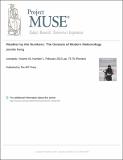Weather by the Numbers: The Genesis of Modern Meteorology
Author(s)
Ferng, Jennifer H.
DownloadFerng-2010-WEATHER BY THE NUMBERS THE GENESIS OF MODERN METEOROLOGY.pdf (917.3Kb)
PUBLISHER_POLICY
Publisher Policy
Article is made available in accordance with the publisher's policy and may be subject to US copyright law. Please refer to the publisher's site for terms of use.
Terms of use
Metadata
Show full item recordAbstract
Farmers sometimes relied upon the
intuition of wind direction, the natural
instincts of animals, imminent storm
clouds and heavy rainfall to predict
how the weather would influence the
prosperity of their forthcoming harvest.
The U.S. Weather Bureau during the
early 1920s, partially composed of several
thousand unpaid volunteers who
collected and transmitted local observations
for regional forecasts that affected
crop and road services, was, at the time,
an ineffective government bureaucracy
that envisaged how extreme heat temperatures
would impact the transport of
livestock and published empirical data
on fruit frost for tobacco and alfalfa
seed districts. Placing the Weather
Bureau as one of the many strategic
organizations at the heart of meteorology’s
expansion into a theoretically
sophisticated science, Kristine Harper traces from World War II into the 1960s
the tribulations and successes of American
and European scientists who introduced
numerical computing techniques
to the art of forecasting the weather as
part of the Meteorology Project based
at the Institute for Advanced Study in
Princeton, New Jersey. She shifts the
spotlight away from the better-known
contributions of mathematical prodigy
John von Neumann and instead accentuates
the daily decisions made by
American meteorologists collaborating
with external Norwegian experts who
possessed more theoretical training and
time-tested experience. Harper challenges
some historians’ interpretations
of von Neumann’s central role in developing
numerical weather prediction,
represented by such works as Frederik
Nebeker’s Calculating the Weather: Meteorology
in the 20th Century (1995) and
William Asprey’s John von Neumann and
the Origins of Modern Computing (1990).
Date issued
2010-02Department
Massachusetts Institute of Technology. Department of ArchitectureJournal
Leonardo
Publisher
MIT Press
Citation
Ferng, Jennifer. Review of “Weather by the Numbers: The Genesis of Modern Meteorology by Kristine C. Harper. MIT Press, Cambridge, MA, U.S.A., 2008. 308 pp., illus. Trade. ISBN: 978-0-262-08378-2.” Leonardo 43.1 (2010): 75-76. ©2010 ISAST.
Version: Final published version
ISSN
0024-094X
1530-9282